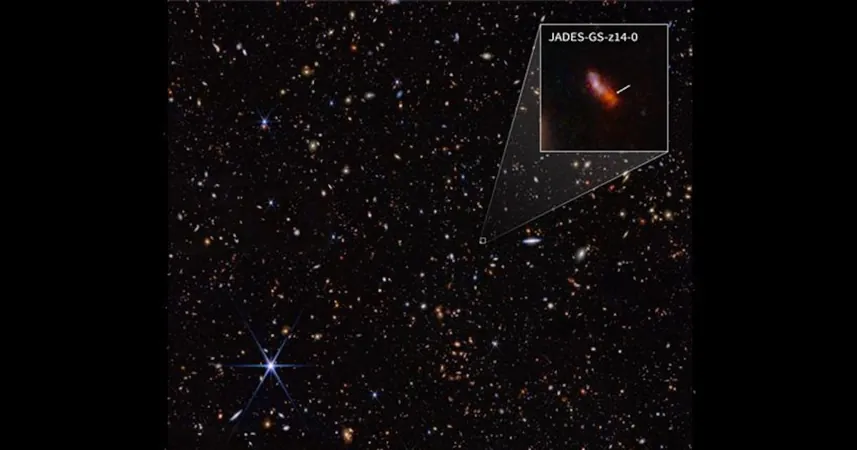
Astronomers Unveil the Universe's Ancient Secrets with New Galaxy Discoveries
2025-05-31
Author: Sarah
A Landmark Discovery in Cosmic History
In a groundbreaking revelation, astronomers have pinpointed the two most distant galaxies ever observed, offering an extraordinary glimpse into the universe just 300 million years post-Big Bang. These galaxies, named JADES-GS-z14-0 and JADES-GS-z14-1, were spotted by the James Webb Space Telescope (JWST) during its ambitious Advanced Deep Extragalactic Survey (JADES).
Challenging Existing Theories
The findings, published in the esteemed journal Nature, are set to challenge long-held beliefs about the rapidity with which galaxies can form in our universe's infancy. Dr. Francesco D’Eugenio from the Kavli Institute for Cosmology at the University of Cambridge, part of the research team, noted, "These galaxies enhance our understanding of stellar populations and the unique patterns of chemical elements that were present in the early cosmos."
Impressive Characteristics of JADES-GS-z14-0
The more luminous of the two, JADES-GS-z14-0, boasts a staggering diameter of around 1,600 light-years and appears teeming with youthful stars. This discovery provides scientists with a precious chance to investigate the conditions surrounding the universe's first formation stage.
A Glimpse Into the Universe's Infancy
Observing these ancient galaxies allows researchers to view them as they were during a time when the universe was less than 2% of its current age. JWST’s sophisticated instruments enabled scientists to study the phenomenon of light stretching — an effect that occurs as light travels vast distances through space.
Potential to Discover Even Older Galaxies
Brant Robertson, an astronomy and astrophysics professor at the University of California-Santa Cruz, emphasized the telescope's capabilities, stating, "We could detect this galaxy even if it were ten times fainter, indicating potential opportunities to observe even earlier galaxies from the universe’s first 200 million years."
Reevaluating Cosmic Development
These revelations may also prompt scientists to rethink the speed at which stars and matter began to coalesce in the cosmos shortly after the Big Bang. The JWST’s advanced ability to detect infrared light sets it apart from its predecessor, the Hubble Space Telescope, allowing for groundbreaking observations.
The JWST: A Transformative Tool in Astronomy
Since its launch on Christmas Day in 2021, the JWST has redefined understanding of the early universe. Its most cited achievements include discovering carbon dioxide in the atmosphere of an exoplanet and offering unprecedented insights into star formation, such as revealing new structures from the iconic Pillars of Creation.
Future of Space Exploration at Risk?
However, despite its successes, the JWST's ongoing research could face threats from the proposed 2026 budget cuts by the White House, jeopardizing crucial scientific missions by NASA. While the telescope is operational, financial constraints may hamper resources necessary for its continued observations or delay follow-up missions to build on its significant findings.


 Brasil (PT)
Brasil (PT)
 Canada (EN)
Canada (EN)
 Chile (ES)
Chile (ES)
 Česko (CS)
Česko (CS)
 대한민국 (KO)
대한민국 (KO)
 España (ES)
España (ES)
 France (FR)
France (FR)
 Hong Kong (EN)
Hong Kong (EN)
 Italia (IT)
Italia (IT)
 日本 (JA)
日本 (JA)
 Magyarország (HU)
Magyarország (HU)
 Norge (NO)
Norge (NO)
 Polska (PL)
Polska (PL)
 Schweiz (DE)
Schweiz (DE)
 Singapore (EN)
Singapore (EN)
 Sverige (SV)
Sverige (SV)
 Suomi (FI)
Suomi (FI)
 Türkiye (TR)
Türkiye (TR)
 الإمارات العربية المتحدة (AR)
الإمارات العربية المتحدة (AR)